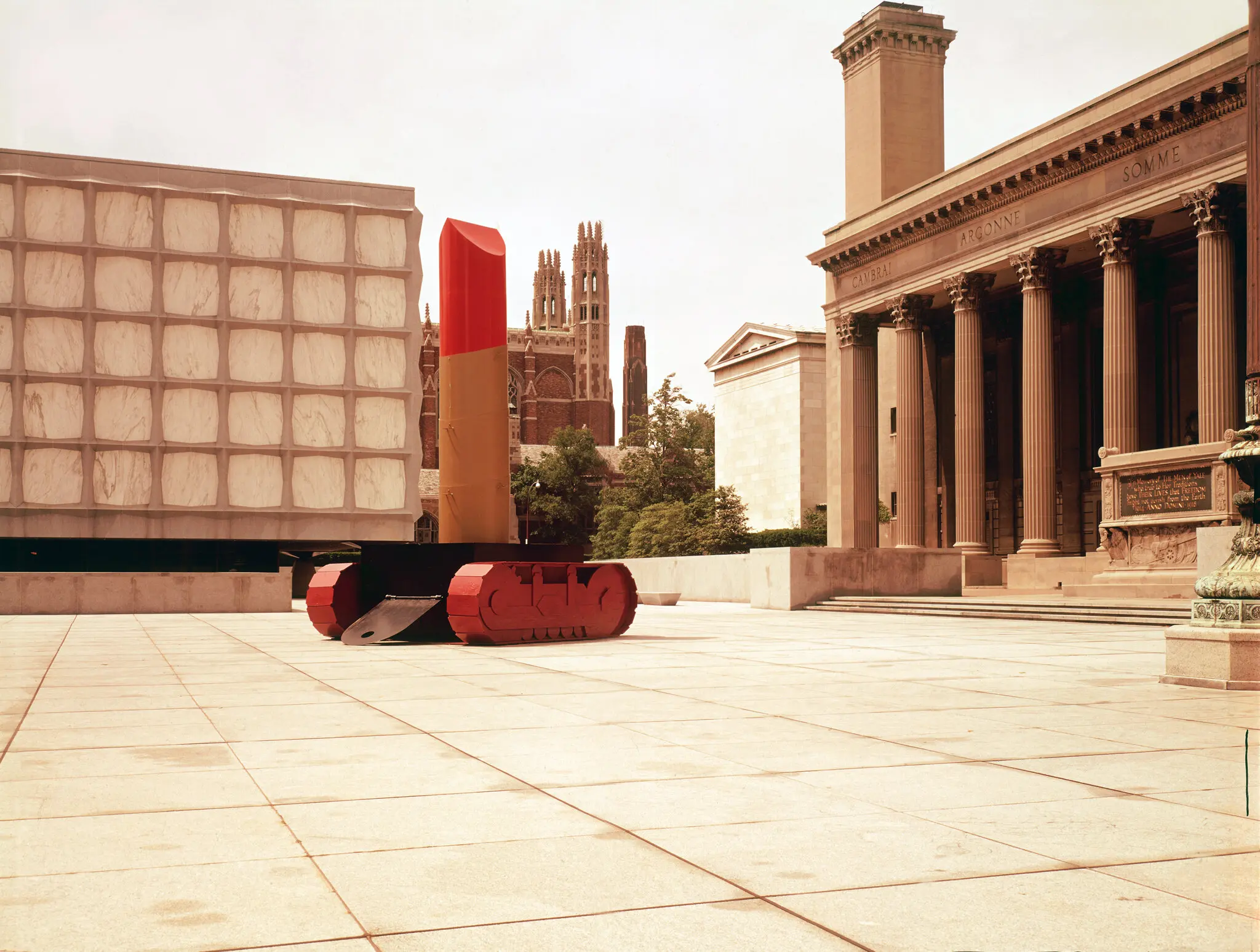
The Pop Artist, whose work is instantly recognisable to almost anyone, passed away at his Manhattan residence two days ago at the age of 93.
In the 1950s when Claes Oldenburg entered the art scene, much of his work was in the mould of the audience-participation ‘Happenings’ movement that was in vogue at the time. What Oldenburg proceeded to do was lead the way in magnanimity – enlarging his sculptures into larger-than-life mega-scale. This was often done with everyday objects placed in visible public spots to jar and provoke pedestrians.
An early project of Oldenburg’s was ‘The Store’ in 1961. The artist opened up a shop window in the East Village and sold absurd plaster facsimiles of everyday objects (a shoe, a cheeseburger out of a comic strip etc.) only covered with the recognizable drips and improvisational dashes of Abstract Expressionism. It was after this that he began to focus much more on sculpture, particularly the scale of the work.

Mr Oldenburg poses in front of an exhibition of his work, the Pop Artist has died at the age of 93
Like us at whynow, Oldenburg was heavily influenced and enamoured by Outsider Art, that which is created by artists outside of the art industrial ‘cathedral’ as it were. People from ordinary life who have been drawn to art by some inexplicable force, and could never operate wholly within the normal bounds of the ‘industry’. You can have a look at some of the stunning work by British Outsider Artists who we have interviewed and profiled on film here.
In opposition to Abstract trailblaizers such as Marcel Duchamp, who placed a urinal and a bicycle wheel into an art exhibition, Oldenburg focused his attention of crafting the objects himself and then enhancing them through imaginative engorgement. This was an artist who wanted the transform these objects from the everyday into the natural and to become “just as mysterious as nature.”
“My intention is to make an everyday object that eludes definition,” Oldenburg once said. He rarely depicted people, instead focusing on items closely associated with human needs and desires. “I’ve expressed myself consistently in objects with reference to human beings rather than through human beings,” he said. As the art dealer Arne Glimcher, who knew and worked with Mr. Oldenburg since the early 1960s put it in an interview on Monday, “His work was almost psychoanalytic.”
Mr. Glimcher noted that precise drawings served as the basis for Mr. Oldenburg’s work. “He was a draughtsman comparable to Ingres or Picasso,” he said, but “with the daring to mess it up.” His most important contribution to sculpture, Mr. Glimcher said, was turning it from something hard, like bronze or wood, to something soft. The sculptures would deflate, and Mr. Glimcher recalled Mr. Oldenburg instructing his associates to “fluff them up.”

“Shuttlecocks” by Mr. Oldenburg and his second wife, Coosje van Bruggen, a series of four sculptures on the grounds of the Nelson-Atkins Museum of Art in Kansas City, Mo.Credit…Claes Oldenburg; via the Oldenburg van Bruggen Studio
Claes Thure Oldenburg was born in Stockholm on 28th January 1929, the son of Gosta and Sigrid Elisabeth (Lindforss) Oldenburg. His father was a diplomat and often had dealings in London, Berlin, Oslo and New York, before being appointed in 1936 as the Swedish consul general in Chicago, where Claes grew up and attended the Latin School of Chicago.
Oldenburg studied literature and art history at Yale University from 1946 to 1950 before returning to the Midwest to undertake a course at the Art Institute of Chicago in the early 1950s with the painter Paul Wieghardt, a student of Paul Klee’s at the modernist Bauhaus school in Weimar, Germany. During his early years in art school, Mr. Oldenburg worked for the City News Bureau of Chicago, where one of his duties included drawing comic strips. He was the only major artist associated with Pop Art to have drawn comics professionally.

“Lipstick (Ascending) on Caterpillar Tracks,” (1969).Credit…Claes Oldenburg; via the Oldenburg van Bruggen Studio
Oldenburg finally became a United States citizen in 1953 and moved to New York in 1956. His first exhibition, at the Judson Gallery in May 1959, included drawings, collages and objects made of papier-mâché.
Before you leave with the impression thinking that Oldenburg’s celebrations of the mundane, think again, because in his view, these objects are far from banal to the modern mind. “A catalog could be made of all such objects,” he was quoted as saying, “which would read like a list of the deities or things on which our contemporary mythological thinking has been projected. We do invest religious emotion in our objects. Look at how beautifully objects are depicted in ads in Sunday newspapers.”


